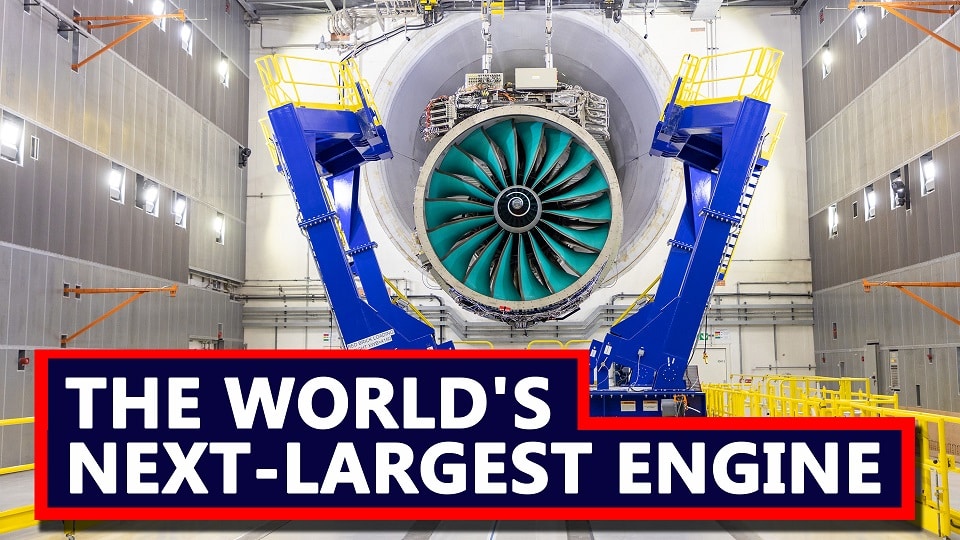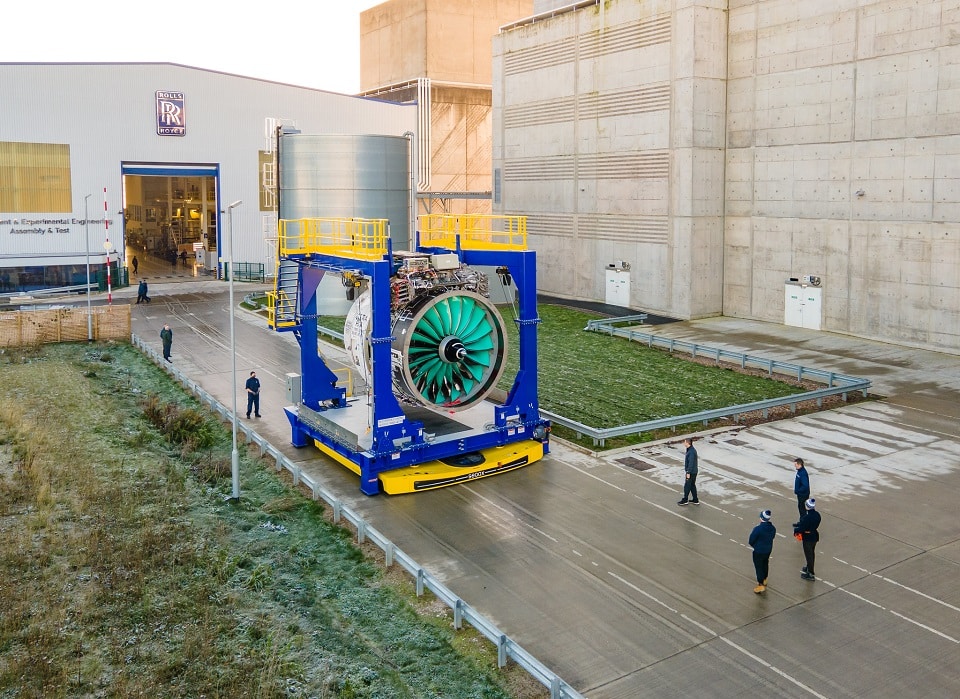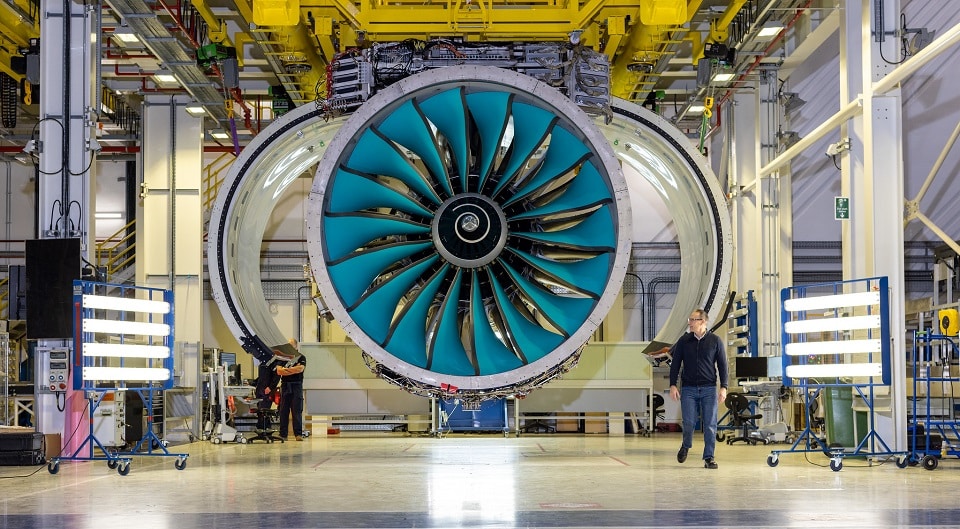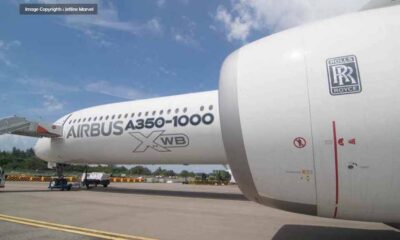Aerospace
The world’s largest engine The Rolls Royce UltraFan: 10 Key Takeaways.

Any aircraft’s basic component, on which its capacity and speed are largely dependent, is its engine. However, recently, the majority of aircraft companies have come under fire for significantly contributing to air pollution in the environment, which causes global warming and other problems.
As a result, companies like General Electric, Rolls Royce, Pratt & Whitney, and others are currently working on developing new types of engines that may both cut carbon emissions and improve operator productivity.
Airlines are concentrating more on sustainable fuel in the near future because it will be the only source that can replace the crude oils that come from the earth’s core and might potentially affect both the environment and our planet.
Therefore, aerospace companies are working to construct engines using 100 SAF fuel, which can be produced naturally in the environment and also causes less harm to the environment.
Rolls Royce in talks with DRDO to rev up AMCA engines(Opens in a new browser tab)
The first prototype of the UltraFan engine, which will be used in future aircraft, was completed by Rolls Royce in December. This engine’s innovation will undoubtedly aid in the achievement of net zero emissions for the environment and the aviation sector. We’ll look at a few fascinating facts about it in this article.
1. The biggest engine in the world
It is the biggest aviation engine Rolls Royce has ever produced, with a fan diameter of about 140 inches. This makes it bigger than the G9x engine, which is now mounted in the Boeing 777x and has a size of 134 inches.
The GE 9x engine has a thrust of roughly 490 kN, whereas this engine can generate 444.82 kN of thrust.
[adinserter block="3"]
2.100% SAF-compatible engine
Additionally, the Rolls-Royce engine is compatible with 100% Sustainable Aviation Fuel, which will be used in the demonstrator’s first test early this year. Rolls Royce has also created engines for Gulfstream aircraft, which are currently also SAF-compatible. In addition, Rolls-Royce is intensively looking into hydrogen and hybrid electric power possibilities.
3. Fan constructed with hollow titanium blades.
Rolls-Royce fan blades are constructed from a unique composite material. Rolls-Royce will switch to carbon composite fan blades from its customary hollow titanium blades, which will result in a 340 kg (750 lb) weight reduction per engine. And because these blades operate at a low speed, they are unique.
[adinserter block="13"]
4. A thrust reverser is not required for this engine.
This engine’s dual engine layout leads to a geared turbofan with a variable pitch fan system that promises an improvement in fuel burn of at least 25%. An overall pressure ratio of 70:1 and a bypass ratio of 15:1 are the goals of the geared/variable pitch UltraFan.
The Advance core is retained in the Ultrafan, which additionally features a geared turbofan architecture with variable-pitch fan blades. The fan won’t require a thrust reverser because it will adjust pitch to be most effective for each flying phase.
5. Low-pressure ratio fan operability will be facilitated by the variable pitch fan.
The initial test gear’s ratio will be close to 4:1, and its thrust could reach 440 kN. (100,000 lbf). Variable-pitch blades rather than a variable area jet nozzle are used to treat low-speed fan instability caused by higher bypass and a lower fan pressure ratio. Moreover, get rid of the thrust reverser.
6. the working of a rolls Royce ultra fan.
After the power gearbox, which generates secondary power thrust in a high-speed engine, the next section is the Advanced Core system, where compressed air will be generated, followed by lean burn combustion, and the last section is a High-Speed multi-stage IP turbine system.
The front fan operates at a low speed and is made of composite material. In comparison to Trent’s first generation, UltraFan is 25% more efficient, produces 40% less NOx, 35% less noise, and nearly no nvPM particles during cruising.
[adinserter block="1"]
7. Are Rolls Royce and the GE 9x engine in competition?
This engine competes quite well with the GE9x engine, which has a similar engine but a somewhat higher thrust and speed ratio. The GE 9x engine was launched and is specifically intended for the Boeing 777x, but in the future, the RR engine might be one of the options for that engine.
However, we can’t say with certainty that this engine will also be installed in the Boeing 777x until we get more information. but I’m still unsure of it.
8. Rolls Royce constructed a unique engine test bed for €84 million ($94 million).
This engine needed a proper test bed and rolls to be tested. In order to understand how an engine behaves in various types of weather environments and tough foreign particulate inject testing, Rolls Royce is already preparing for testing in February 2023. In addition, the engine will undergo standby time testing, which could be crucial for any engine manufacturer.
The company built The cost of the specially built test equipment is €84 million ($94 million). Rolls-Royce has constructed a power rig near Dahlewitz, close to Berlin, with a capacity of 15–80 MW (20,000–107,000 hp) gear sets, simulating loading circumstances in flight;
9. UltraFan’s scalable technology
The engine will be employed in the upcoming aircraft, providing safe operations and 100% utilization of SAF fuel. increased efficiency and lower carbon emissions for airplanes let airlines increase their profits. UltraFan’s scalable technology from ~25,000-110,000lb thrust delivers the potential to further improve the fuel efficiency of both narrowbody and widebody aircraft by up to 10 percent.
[adinserter block="2"]
10. UK and EU technology collaboration
In the nearer term, there are options to transfer technologies from the UltraFan development program to current Trent engines to deliver enhanced fuel efficiency and reductions in emissions. The UltraFan technology demonstrator program has been supported by the UK’s Aerospace Technology Institute and Innovate UK, the EU’s Clean Sky programs plus LuFo and the State of Brandenburg in Germany.
Read more: Click here

Aerospace
China Secures Production Certificate for Mass Production of Pilotless eVTOL Aircraft

The first passenger-carrying pilotless electric vertical takeoff and landing (eVTOL) aircraft in the world, the EH216-S, has received the Production Certificate for its eVTOL aircraft from the Civil Aviation Administration of China (CAAC).
This is a significant milestone for EHang Holdings Limited, the leading UAM technology platform company in the world. This outstanding accomplishment is another big step towards mass manufacturing for the eVTOL aircraft and the ensuing commercial operations, building on the ground-breaking acquisition of the Type Certificate and the Standard Airworthiness Certificate for the EH216-S.
The PC is a crucial certificate that the aircraft maker receives from the CAAC, the country’s aviation authority. By obtaining this certificate, EHang has demonstrated that it has set up a quality management system for mass production that satisfies the airworthiness regulation standards set forth by the CAAC, and the company has been given permission to continue producing mass quantities.
It is also a strong guarantee of the calibre of the goods made by EHang. Raw materials, supplier management, manufacturing organisation, production quality control, aircraft pre-delivery test, after-sales repair and maintenance, etc. are all included in the mass production quality management system for the EH216-S.
To ensure that every aircraft and its components that roll off the production line strictly adhere to the approved type design and safety requirements, the system sets clear guidelines and documentation for every step in the production procedure. This ensures comprehensive traceability and safety control.
Aerospace
Four Airbus A380 Superjumbos lined up to be scrapped

In a strategic move aimed at reclaiming valuable resources from the iconic Airbus A380 aircraft, VAS Aero Services and Dr. Peters Group have announced a significant collaboration.
This partnership marks a milestone in aviation logistics and aftermarket services, with four of these colossal planes slated for teardown and redistribution of used serviceable material (USM).
The venture between VAS Aero Services, renowned for its expertise in aircraft dismantlement, and Dr. Peters Group, a prominent Germany-based investment fund management firm, underscores a commitment to sustainable aviation practices. This isn’t their first foray into scrapping A380s; their successful partnership has already seen the dismantlement of these aircraft, making them pioneers in this niche.
Under the agreement, the latest consignment brings the tally to eight A380s entrusted to VAS by Dr. Peters Group. Managing Director Christian Mailly of Dr. Peters Group emphasized the trust placed in VAS, citing their unparalleled capabilities in dismantlement and aftermarket sales network. It’s a strategic move in response to the growing demand for quality USM parts, particularly with the resurgence in reliance on the A380.
Notably, the teardown process will be carried out at various locations, optimizing the positioning of harvested parts to cater to different markets. While some parts will be positioned in Europe to support operators in the region and the Middle East, others will remain in the Asia-Pacific region. This meticulous strategy ensures efficient access to spare parts, benefiting MROs and airlines across these markets.
The decision to retire these A380s comes at a time when operators are reassessing fleet strategies amidst evolving market dynamics. Despite initial plans for quick retirement due to the emergence of more fuel-efficient alternatives, factors such as a rebound in long-haul demand and delays in new widebody deliveries have prompted operators to reconsider. The A380, with its unique capacity and capabilities, presents a practical solution for short-term capacity management.
Aerospace
Rolls-Royce Launches Test Flights for Revolutionary Pearl 10X Engine

Rolls-Royce reports that the company’s dedicated Boeing 747 flying testbed has seen the successful start of the Pearl 10X, their newest aero engine designed for the business aviation industry.
Dassault, a French aircraft manufacturer, has decided to use this engine only to power their newest flagship, the Falcon 10X. As stated at last year’s Capital Markets Day, the commencement of flight testing represents a significant milestone for both Rolls-Royce and the Pearl 10X programme as the company concentrates on expanding in the business aviation industry.
The first Rolls-Royce engine to power a Dassault business jet is the Pearl 10X, the newest engine in the state-of-the-art Pearl engine family. The Pearl 10X was chosen by the French aircraft manufacturer as their new flagship model, demonstrating even more of Rolls-Royce’s dominance in the business aviation engine market.
Over the next few months, pilots and flight test engineers from Tucson, Arizona, USA, will put the engine through its paces. The flight test programme will comprise testing of the nacelle’s anti-icing system, in-flight relights, engine performance and handling checks at various speeds and altitudes, and fan vibration tests at various altitudes.
The new auxiliary gearbox, which enables higher additional power extraction, and the ultra-low emissions ALM combustor, which is compatible with 100% Sustainable Aviation Fuel (SAF), have undergone extensive testing as part of the ground-based development programme thus far. The engine will be the most potent business aviation engine in the Rolls-Royce lineup. It exceeded its intended thrust levels during the very first test run. With over 2,300 testing hours successfully completed on the Pearl 10X engine configuration as well as the Advance 2 demonstration, the programme is moving forward at a rapid pace.
With the most economical engine core available for business aircraft, the Advance2 engine, coupled with a high-performance low-pressure system, gives the Pearl 10X an exceptional thrust of over 18,000 lbf. With a 5% increase in economy over the previous generation of Rolls-Royce commercial aviation engines, the Pearl 10X




























